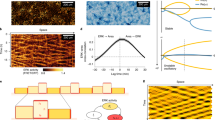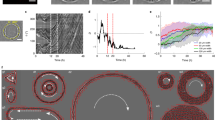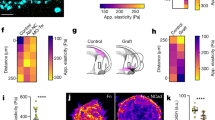Abstract
Many normal and pathological biological processes involve the migration of epithelial cell sheets. This arises from complex emergent behaviour resulting from the interplay between cellular signalling networks and the forces that physically couple the cells. Here, we demonstrate that collective migration of an epithelium can be interactively guided by applying electric fields that bias the underlying signalling networks. We show that complex, spatiotemporal cues are locally interpreted by the epithelium, resulting in rapid, coordinated responses such as a collective U-turn, divergent migration, and unchecked migration against an obstacle. We observed that the degree of external control depends on the size and shape of the cell population, and on the existence of physical coupling between cells. Together, our results offer design and engineering principles for the rational manipulation of the collective behaviour and material properties of a tissue.
This is a preview of subscription content, access via your institution
Access options
Subscribe to this journal
Receive 12 print issues and online access
$259.00 per year
only $21.58 per issue
Buy this article
- Purchase on Springer Link
- Instant access to full article PDF
Prices may be subject to local taxes which are calculated during checkout






Similar content being viewed by others
Change history
21 March 2014
In the version of this Article originally published, in Figs 4a,e, 5b,c and 6a, the units for velocity should have read 'μm h–1'. This error has now been corrected in the online versions of the Article.
References
Zitterbart, D. P., Wienecke, B., Butler, J. P. & Fabry, B. Coordinated movements prevent jamming in an Emperor penguin huddle. PLoS ONE 6, e20260 (2011).
Cavagna, A. et al. Scale-free correlations in starling flocks. Proceedings 107, 11865–11870 (2010).
Gordon, D. M. The rewards of restraint in the collective regulation of foraging by harvester ant colonies. Nature 498, 91–93 (2013).
Vicsek, T. & Zafeiris, A. Collective motion. Phys. Rep. 517, 71–140 (2012).
Zheng, Z., Ahn, S., Chen, D. & Laval, J. Freeway traffic oscillations: microscopic analysis of formations and propagations using wavelet transform. Procedia 17, 702–716 (2011).
Trepat, X. et al. Physical forces during collective cell migration. Nature Phys. 5, 426–430 (2009).
Angelini, T. E. et al. Glass-like dynamics of collective cell migration. Proc. Natl Acad. Sci. USA 108, 4714–4719 (2011).
Tambe, D. T. et al. Collective cell guidance by cooperative intercellular forces. Nature Mater. 10, 469–475 (2011).
Kim, J. H. et al. Propulsion and navigation within the advancing monolayer sheet. Nature Mater. 12, 1–8 (2013).
Poujade, M. et al. Collective migration of an epithelial monolayer in response to a model wound. Proc. Natl Acad. Sci. USA 104, 15988–15993 (2007).
Ram, S. et al. Emerging modes of collective cell migration induced by geometrical constraints. Proc. Natl Acad. Sci. USA 109, 12974–12979 (2012).
Anon, E. et al. Cell crawling mediates collective cell migration to close undamaged epithelial gaps. Proc. Natl Acad. Sci. USA 109, 10891–10896 (2012).
Serra-Picamal, X. et al. Mechanical waves during tissue expansion. Nature Phys. 8, 628–634 (2012).
Petitjean, L. et al. Velocity fields in a collectively migrating epithelium. Biophys. J. 98, 1790–1800 (2010).
Bialek, W. et al. Statistical mechanics for natural flocks of birds. Proc. Natl Acad. Sci. USA 109, 4786–4791 (2012).
Sun, Y. et al. Self-organizing circuit assembly through spatiotemporally coordinated neuronal migration within geometric constraints. PLoS ONE 6, e28156 (2011).
Friedl, P., Hegerfeldt, Y. & Tusch, M. Collective cell migration in morphogenesis and cancer. Int. J. Dev. Biol. 48, 441–449 (2004).
Friedl, P. & Gilmour, D. Collective cell migration in morphogenesis, regeneration and cancer. Nature Rev. Mol. Cell Biol. 10, 445–457 (2009).
Vasilyev, A. et al. Collective cell migration drives morphogenesis of the kidney nephron. PLoS Biol. 7, e9 (2009).
Bianco, A. et al. Two distinct modes of guidance signalling during collective migration of border cells. Nature 448, 362–365 (2007).
Selmeczi, D. Phase transition in the collective migration of tissue cells: Experiment and model. Phys. Rev. E 74, 1–5 (2006).
Mccann, C. P., Kriebel, P. W., Parent, C. A. & Losert, W. Cell speed, persistence and information transmission during signal relay and collective migration. J. Chem. Sci. 123, 1724–1731 (2010).
Vitorino, P. & Meyer, T. Modular control of endothelial sheet migration. Genes Dev. 1, 3268–3281 (2008).
McCaig, C. D., Song, B. & Rajnicek, A. M. Electrical dimensions in cell science. J. Cell Sci. 122, 4267–4276 (2009).
Forrester, J. V, Lois, N., Zhao, M. & McCaig, C. The spark of life: the role of electric fields in regulating cell behaviour using the eye as a model system. Ophthal. Res. 39, 4–16 (2007).
Zhao, M. Electrical fields in wound healing-an overriding signal that directs cell migration. Semin. Cell Dev. Biol. 20, 674–682 (2009).
Caig, C. D. M. C., Rajnicek, A. N. N. M., Song, B. & Zhao, M. I. N. Controlling cell behavior electrically?: Current views and future potential. Phys. Rev. 943–978 (2005).
Nagel, W. Ueber Galvanotaxis. Pflügers Arch. Bd 59, 603–642 (1895).
Allen, G. M., Mogilner, A. & Theriot, J. A. Electrophoresis of cellular membrane components creates the directional cue guiding keratocyte galvanotaxis. Curr. Biol. 23, 560–569 (2013 ).
Sun, Y. et al. Keratocyte fragments and cells utilize competing pathways to move in opposite directions in an electric field. Curr. Biol. 23, 569–574 (2013).
Cooper, M. S. & Keller, R. E. Perpendicular orientation and directional migration of amphibian neural crest cells in dc electrical fields. Proc. Natl Acad. Sci. USA 81, 160–164 (1984).
Reid, B., Nuccitelli, R. & Zhao, M. Non-invasive measurement of bioelectric currents with a vibrating probe. Nature Protoc. 2, 661–669 (2007).
Yao, L., Pandit, A., Yao, S. & Mccaig, C. D. Electric field-guided neuron migration?: A novel approach in neurogenesis. Tissue Eng. B 17, 1–11 (2011).
Hammerick, K. E., Longaker, M. T. & Prinz, F. B. In vitro effects of direct current electric fields on adipose-derived stromal cells. Biochem. Biophys. Res. Commun. 397, 12–17 (2010).
Zhao, M. et al. Electrical signals control wound healing through phosphatidylinositol-3-OH kinase-γ and PTEN. Nature 442, 457–460 (2006).
Robinson, K. R. The responses of cells to electrical fields: a review. J. Cell Biol. 101, 2023–2027 (1985).
Erickson, C. A. & Nuccitelli, R. Can be influenced by physiological electric fields embryonic fibroblast motility and orientation. J. Cell Biol. 98, 296–307 (1984).
Nishimura, K. Y., Isseroff, R. R. & Nuccitelli, R. Human keratinocytes migrate to the negative pole in direct current electric fields comparable to those measured in mammalian wounds. J. Cell Sci. 109 Pt 1, 199–207 (1996).
Song, B. et al. Application of direct current electric fields to cells and tissues in vitro and modulation of wound electric field in vivo. Nature Protoc. 2, 1479–1489 (2007).
Li, L. et al. E-cadherin plays an essential role in collective directional migration of large epithelial sheets. Cell. Mol. Life Sci. 69, 2779–2789 (2012).
Huang, C-W., Cheng, J-Y., Yen, M-H. & Young, T-H. Electrotaxis of lung cancer cells in a multiple-electric-field chip. Biosens. Bioelectron. 24, 3510–3516 (2009).
Tsai, H-F., Peng, S-W., Wu, C-Y., Chang, H-F. & Cheng, J-Y. Electrotaxis of oral squamous cell carcinoma cells in a multiple-electric-field chip with uniform flow field. Biomicrofluidics 6, 034116 (2012).
Song, S., Han, H., Ko, U. H., Kim, J. & Shin, J. H. Collaborative effects of electric field and fluid shear stress on fibroblast migration. Lab Chip 13, 1602–1611 (2013).
Doxzen, K. et al. Guidance of collective cell migration by substrate geometry. Integr. Biol. (Camb). 5, 1026–1035 (2013).
Mark, S. et al. Physical model of the dynamic instability in an expanding cell culture. Biophys. J. 98, 361–370 (2010).
Rolli, C. G. et al. Switchable adhesive substrates: revealing geometry dependence in collective cell behaviour. Biomaterials 33, 2409–2418 (2012).
Abercrombie, M. Contact inhibition in tissue culture. In Vitro 6, 128–42 (1970).
Puliafito, A. et al. Collective and single cell behaviour in epithelial contact inhibition. Proc. Natl Acad. Sci. USA 109, 739–744 (2012).
Acknowledgements
We thank the following for reagents and advice: N. Borghi (Institut Jacques Monod, Paris); K. Matlin (Univ. Chicago); D.J. Seo (UC Berkeley); M. Lowndes (Stanford University); C. Tropini (Stanford University); W. Marshall (UCSF); S. Prabhu (UCLA) and J. Bone (UC Berkeley). This work was supported by a Graduate Fellowship from the NSF to D.J.C., HFSP (RGP0040/2012) to W.J.N., and EFRI-1240380 to M.M.M.
Author information
Authors and Affiliations
Contributions
D.J.C. designed and built the device, designed and performed experiments, and analysed and interpreted data. W.J.N. interpreted biological data. M.M.M. contributed to the design of the device. All authors participated in writing the paper.
Corresponding author
Ethics declarations
Competing interests
The authors declare no competing financial interests.
Supplementary information
Supplementary Information
Supplementary Information (PDF 554 kb)
Supplementary Information
Supplementary Movie S1 (AVI 11790 kb)
Supplementary Information
Supplementary Movie S2 (AVI 8439 kb)
Supplementary Information
Supplementary Movie S3 (AVI 10896 kb)
Supplementary Information
Supplementary Movie S4 (AVI 9232 kb)
Supplementary Information
Supplementary Movie S5 (AVI 24871 kb)
Rights and permissions
About this article
Cite this article
Cohen, D., James Nelson, W. & Maharbiz, M. Galvanotactic control of collective cell migration in epithelial monolayers. Nature Mater 13, 409–417 (2014). https://doi.org/10.1038/nmat3891
Received:
Accepted:
Published:
Issue Date:
DOI: https://doi.org/10.1038/nmat3891
This article is cited by
-
A machine learning based model accurately predicts cellular response to electric fields in multiple cell types
Scientific Reports (2022)
-
Transepithelial potential difference governs epithelial homeostasis by electromechanics
Nature Physics (2022)
-
Electric field stimulation for tissue engineering applications
BMC Biomedical Engineering (2021)
-
An Easy-to-Fabricate Cell Stretcher Reveals Density-Dependent Mechanical Regulation of Collective Cell Movements in Epithelia
Cellular and Molecular Bioengineering (2021)
-
Electromagnetic fields alter the motility of metastatic breast cancer cells
Communications Biology (2019)



